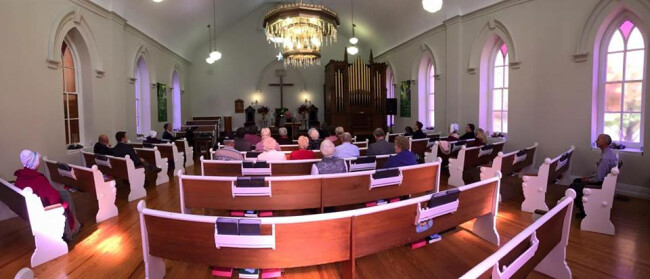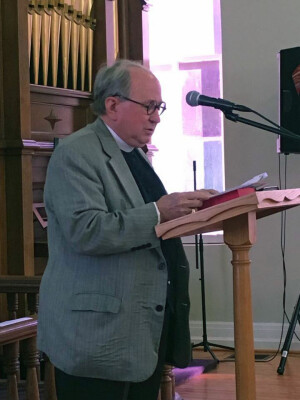Strawbridge Shrine members gather for living history
By Linda Worthington
UMConnection Staff

Members and friends of the Strawbridge Shrine Association gathered at Stone Chapel UMC in October for their 2016 annual meeting, themed “Upon this Rock.” Nestled in rural Maryland near New Windsor, Stone Chapel is only a few miles from the Strawbridge Shrine.

The Rev. Emora Brannan speaks at the Strawbridge Shrine Association annual meeting, held in
In addition to conducting important business, the annual meeting also provides an opportunity for worship and a special historical presentation. The guest speaker for this year’s historical presentation was the Rev. Emora Brannan, conference historian
The opening worship included collects, hymns
In his presentation, Brannan spoke on the relationship between Robert Strawbridge and Francis Asbury (not yet bishop), for whom the 200th year of his death was commemorated in 2016.
Soon after the Strawbridges came to America in the mid-1700s, Brannan said, Robert began preaching to all who could or would gather to listen, leaving Elizabeth to run the farm and raise their six children. Today, that house, which was the gathering place for the first Methodist meetings, is the heart of the Shrine.
Robert built a log meeting house, a replica of which is at the Shrine, and for 16 years planted Methodism in Virginia, Pennsylvania
Francis Asbury arrived in 1771, responding to John Wesley’s call for volunteers to go to America. He soon heard of Robert Strawbridge, and both were appointed to Maryland. Here a conflict between them began over the administration of the Lord’s Supper, both its frequency and methodology. Strawbridge, who was not ordained, was soon admonished by Asbury.
The 1775 conference prohibited Strawbridge, a layman, from administering Communion, but he insisted on meeting the demands from his constituents and he continued. This went on for several years and, by 1780, there were two conferences, one among southerners who suspended any action on the question until Asbury could consult with John Wesley. As Strawbridge established two new churches, at Pipe Creek and Bush (near Aberdeen), he continued to administer the sacraments whenever he wanted. By a year later, in 1781, Strawbridge was dead.
They didn’t agree, but whenever their paths crossed at conferences or when they met, they were amicable, Brannan said. They worked together to increase the number of
In spite of their differences, Brannan said, “Asbury had to appreciate the legacy of Robert Strawbridge, who had built up Methodist churches throughout a vast area from Virginia to New Jersey. It was a rock upon which Francis Asbury could build.”
The two men now lie a few feet apart in Mt. Olivet Cemetery in Baltimore.
During the annual meeting, the Rev. James F.W. Talley, president of the association, praised the Board of Directors “who offer expertise in United Methodist history, knowledge and experience – not just of buildings and structures, but of the theology and scriptural interpretation of those saints who formed the vibrant Methodist movement beginning with the Wesleys and continuing to this day.”
Not everything is history. Talley presented an award to Keith Palmer for removing nearly two dozen groundhogs from the foundations of the barn building on the Shrine property, “for doing what needs to be done,” he said. He announced that board director, the Rev. Doug Tzan, pastor at Sykesville Parish, received the Jesse Lee Prize, a quadrennial award, from the General Commission on Archives and History.
John Strawbridge, the Communications Coordinator, and the great-great-great-great-great grandson of Robert and Elizabeth
